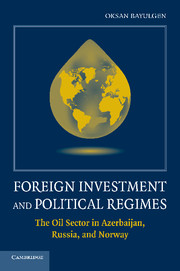Book contents
- Frontmatter
- Contents
- List of Figures and Tables
- Acknowledgments
- 1 Introduction
- 2 Political Risks in Oil Investments: A History of Antagonistic Interdependence Between Companies and Host-Governments
- 3 With or Without Democracy? The Political Economy of Foreign Direct Investments
- 4 Curse or Blessing? Effects of FDI on Development
- 5 Azerbaijan: One-Stop Shopping
- 6 Russia: Two Steps Forward, One Step Back
- 7 Norway: Icon of Stability
- 8 Beyond Three Cases and Oil
- 9 Conclusion
- References
- Index
6 - Russia: Two Steps Forward, One Step Back
Published online by Cambridge University Press: 03 May 2010
- Frontmatter
- Contents
- List of Figures and Tables
- Acknowledgments
- 1 Introduction
- 2 Political Risks in Oil Investments: A History of Antagonistic Interdependence Between Companies and Host-Governments
- 3 With or Without Democracy? The Political Economy of Foreign Direct Investments
- 4 Curse or Blessing? Effects of FDI on Development
- 5 Azerbaijan: One-Stop Shopping
- 6 Russia: Two Steps Forward, One Step Back
- 7 Norway: Icon of Stability
- 8 Beyond Three Cases and Oil
- 9 Conclusion
- References
- Index
Summary
In its first decade of independence, Russia received far less foreign investment than it could have received, both relative to the size of its economy and compared to other emerging markets. According to the World Investment Report, Russia has shown a “below potential” investment performance throughout the 1990s. In terms of the inward Foreign Direct Investment (FDI) performance index, among approximately 140 countries, Russia ranked the 108th and 104th highest during 1992–1994 and 1998–2000, respectively. FDI constituted approximately 6 percent of gross fixed capital formation in Russia between 1995 and 1999. In per capita terms, Russia's poor performance in attracting FDI is revealed more starkly. Between 1989 and 1997, Russia attracted a cumulative inflow of FDI per capita equivalent to only US$63; this figure contrasts with an inflow of US$1,667 per capita in the case of Hungary; and US$823 per capita in the case of the Czech Republic. Russia's overall performance in attracting FDI ranked twentieth out of twenty-five countries in the post-Communist region in terms of FDI per capita.
The oil sector has not been much of an exception for Russia in terms of attracting FDI. The amount of foreign capital inflow to this sector paralleled its poor investment performance in other sectors.
- Type
- Chapter
- Information
- Foreign Investment and Political RegimesThe Oil Sector in Azerbaijan, Russia, and Norway, pp. 122 - 182Publisher: Cambridge University PressPrint publication year: 2010



